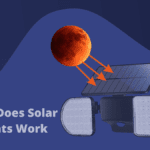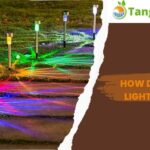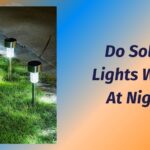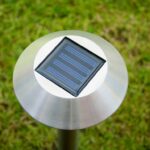How do solar lights work at night? Illuminate your way with solar power
Solar lights work at night by using photovoltaic cells to absorb sunlight during the day, which is then stored in a rechargeable battery. Once the sun sets, the stored energy is used to power the LED lights, providing illumination without the need for an electrical power source.
The photovoltaic cells convert sunlight into electricity through a process called the photovoltaic effect. This technology allows solar lights to operate efficiently and sustainably, making them an environmentally friendly and cost-effective lighting solution for outdoor spaces. The use of solar lights not only reduces energy consumption but also eliminates the hassle of wiring and electrical connections, making them easy to install and maintain.
With their ability to harness the power of the sun, solar lights offer a reliable and eco-friendly option for night-time illumination.
The Basics Of Solar Lights And How They Work
Understanding how solar lights work can enhance your appreciation for these sustainable lighting solutions. As renewable and eco-friendly alternatives to traditional lighting options, solar lights offer a range of benefits, including energy efficiency and cost-saving potential.
How Solar Lights Harness The Power Of The Sun
Solar lights rely on photovoltaic cells, commonly known as solar panels, to convert sunlight into electricity. When sunlight hits these cells, the photons in the sunlight dislodge electrons from their atoms, creating an electric current.
Once the sensor detects darkness or a certain level of low light, it triggers the light to turn on. This allows the stored energy in the battery to power the light source, whether it be an LED (light-emitting diode) or another type of bulb.
Key Components Of A Solar Light System
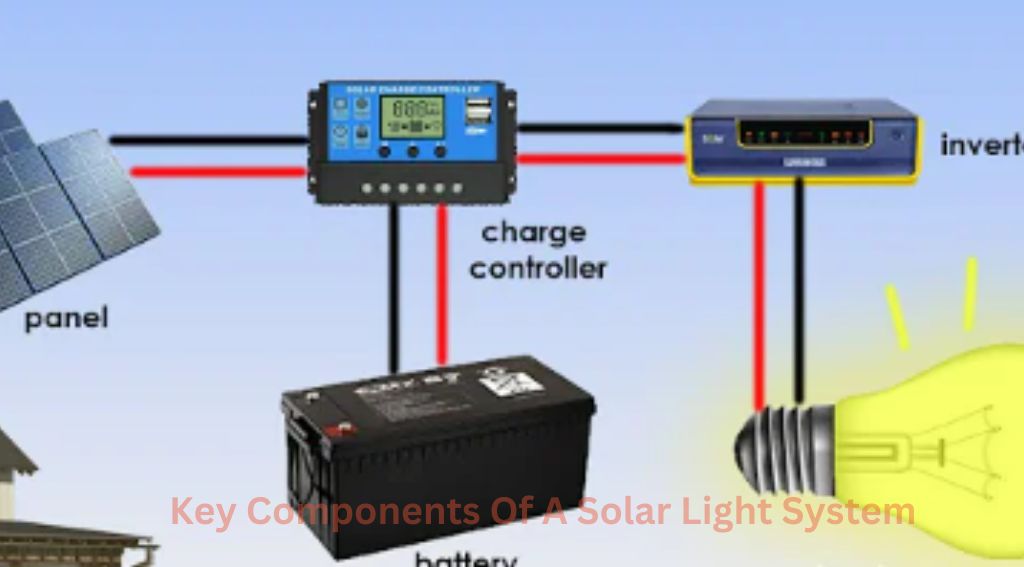
A typical solar light system consists of several key components that work together to provide illumination:
- Solar Panel: The solar panel is responsible for capturing sunlight and converting it into electricity. It is usually mounted on the top of the light fixture, facing the sun for maximum exposure.
- Battery: The rechargeable battery stores the converted solar energy during the day to power the light at night. It is typically a long-lasting and low-maintenance battery.
- Light Source: The light source, often an LED, consumes the stored energy to produce light. LED lights are favored for their energy efficiency and long lifespan.
- Controller: The controller regulates the flow of electricity between the solar panel, battery, and light source. It ensures proper charging of the battery and controls when the light turns on and off based on the ambient light conditions.
- Enclosure: The enclosure protects the components of the solar light system from various outdoor elements such as moisture, dust, and temperature fluctuations.
By understanding the basics of solar lights and how they work, you can make better-informed decisions when it comes to choosing and utilizing solar lighting solutions. The harnessing of solar power during the day and its conversion into electricity to illuminate your surroundings at night demonstrates the remarkable potential of renewable energy in our everyday lives.
Solar Panels: Capturing Sunlight For Energy
solar lights work at night and have gained popularity in recent years due to their cost-effective and environmentally friendly nature. These lights harness the power of the sun to operate at night, eliminating the need for traditional electrical wiring. Solar panels play a crucial role in enabling solar lights to function effectively by capturing sunlight and converting it into electrical energy.
The Role Of Solar Panels In Solar Light Systems
Solar panels serve as the backbone of solar lights and work at night. They are responsible for capturing sunlight and converting it into usable electrical energy. Without solar panels, solar lights would not be able to operate at night or during cloudy days.
How Solar Panels Convert Sunlight Into Electrical Energy
Solar panels achieve the conversion of sunlight into electrical energy through a process called the photovoltaic effect. This effect occurs within the solar cells that make up the solar panel. Each solar cell contains two layers of semiconducting material, usually made of silicon. When sunlight strikes these layers, it excites the electrons, causing them to flow, creating an electric current.
DC electricity is the form of electric current that the solar cells generate. However, since most household appliances and lights operate on alternating current (AC), an inverter is used to convert the DC electricity into AC electricity suitable for powering the solar lights. This conversion ensures that the solar lights can operate efficiently and provide the necessary illumination at night.
The Different Types Of Solar Panels Used In Solar Lights
There are several types of solar panels used in solar lights, each with unique characteristics and benefits:
- Monocrystalline solar panels: These panels are made from a single crystal structure, resulting in high efficiency and excellent performance even in low-light conditions. They are known for their sleek appearance and durability, making them a popular choice for solar lights.
- Polycrystalline solar panels: These panels are made up of multiple crystal structures, which gives them a distinct blue color. Polycrystalline panels are cost-effective and have good efficiency levels, making them a practical choice for solar lights.
- Amorphous solar panels: Also known as thin-film solar panels, amorphous panels are flexible and lightweight. They offer excellent performance in low-light conditions and can be easily integrated into various solar light designs.
Each type of solar panel has its advantages and is suitable for different solar light applications. By understanding the different types of solar panels, it becomes easier to choose the most appropriate option for specific lighting needs.
Battery: Storing And Distributing Solar Energy
As solar lights rely on the power of the sun to illuminate the night, they must have a reliable energy storage system. This is where batteries play a vital role in ensuring consistent functionality, even when the sun goes down. The function and importance of batteries in solar lights cannot be underestimated. In this section, we’ll explore how batteries store and release solar energy, as well as the different types of batteries used in solar lights.
The Function And Importance Of Batteries In Solar Lights
Batteries serve as the backbone of solar lights work at night, allowing them to store and distribute the energy absorbed during the day. Simply put, the battery serves as a reservoir for the extra energy that the solar panel produces.
One might wonder, Why not use the solar panel directly to power the light? The answer lies in the inconsistent nature of solar energy availability. Batteries solve this problem by providing a reliable source of stored energy.
How Batteries Store And Release Solar Energy
To understand how batteries store and release solar energy, it’s essential to know a little about their internal workings. Solar lights typically employ rechargeable batteries, which is ideal for their intermittent energy requirements. These batteries store energy in the form of chemical reactions.
During the day, when the solar panel absorbs sunlight and converts it into electrical energy, the rechargeable batteries get charged. The conversion process involves the sunlight activating the crystalline structure within the solar panel, which generates electrons that move through the circuit and into the battery, charging it. The battery, in turn, stores this energy for later use.
When night falls and the solar panel no longer generates electricity, the battery steps up to provide the necessary power. The chemical reactions within the battery allow the stored energy to be released in a controlled manner, powering the LED lights of the solar light.
Exploring Different Types Of Batteries Used In Solar Lights
Various types of batteries are used in solar lights, each offering its own set of advantages and characteristics. Here are a few commonly used ones:
| Battery Type | Advantages |
| Lithium-ion (Li-ion) | Environmentally friendlyGood performance in extreme temperatures and longer lifespan than NiCd batteries |
| Nickel-metal hydride (NiMH) | Environmentally friendlyGood performance in extreme temperatures and a longer lifespan than NiCd batteries |
| Lead-acid | High energy density, long-lasting, reliable performanceLightweight |
These are just a few examples of batteries commonly used in solar lights. The choice of battery depends on several factors, such as cost, required energy capacity, size, and application-specific needs.
Light Sensor: Automating Illumination
Solar lights are a sustainable and eco-friendly lighting solution that harnesses the power of the sun to illuminate outdoor spaces. One of the key features that allows solar lights to work efficiently is the light sensor, which automates the illumination process. By detecting changes in ambient light, light sensors enable solar lights to turn on at dusk and turn off at dawn, providing a hassle-free lighting experience.
The Role Of Light Sensors In Solar Light Systems
Light sensors play a vital role in solar lights’ work at night, as they act as the control mechanism for turning the lights on and off. These sensors are designed to detect changes in ambient light levels, allowing the solar lights to adjust their operation accordingly.
How Light Sensors Detect Changes In Ambient Light
This cell consists of layers of specially treated silicon and other materials that generate a small electric current when exposed to light. When the amount of light hitting the sensor decreases, such as during sunset or in low-light conditions, the cell’s electrical current diminishes. This change in current triggers the light sensor to activate the solar lights, ensuring that they start emitting light to provide the necessary illumination.
The Benefits Of Using Light Sensors In Solar Lights
Using light sensors in solar lights offers various benefits in terms of energy efficiency, convenience, and cost-effectiveness.
| Energy efficiency: | Light sensors ensure that solar lights only operate when needed, conserving energy for when it’s truly necessary. By automatically adjusting the lighting based on ambient light levels, these sensors prevent the lights from unnecessarily consuming energy during daylight hours. |
| Convenience: | Light sensors’ automation saves users time and effort by eliminating the need for manual operation. Solar lights with light sensors can be installed once and then left to function autonomously without requiring any intervention or adjustment. |
| Cost-effectiveness: | By utilizing light sensors, solar lights help reduce electricity costs since they primarily rely on solar energy. This sustainable lighting solution can help minimize the reliance on traditional electricity sources, resulting in long-term savings. |
With their ability to automate illumination based on ambient light changes, light sensors are crucial components in solar light systems. By harnessing the power of the sun and utilizing light sensors, solar lights offer a reliable and energy-efficient lighting solution for various outdoor spaces.
The Advantages Of LED Lights In Solar Light Systems
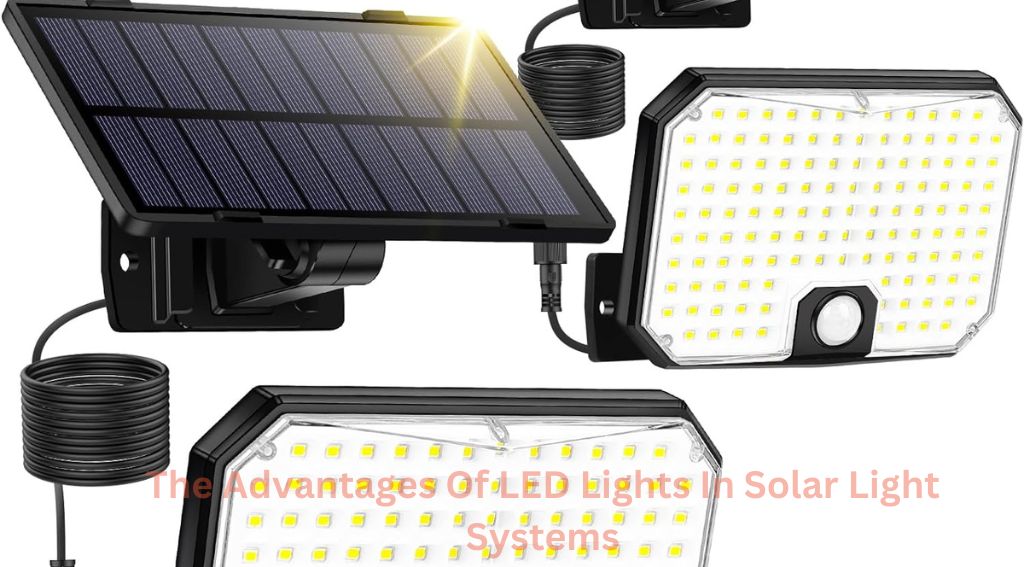
LED lights have revolutionized the way solar light systems work, offering efficient and long-lasting illumination. Unlike traditional lighting options, LED lights provide several advantages that make them the preferred choice for solar-powered lighting solutions.
How Led Lights Provide Bright And Reliable Illumination
Thanks to their advanced technology, LED lights efficiently convert electricity into light, ensuring optimal brightness. This means that solar lights with LED bulbs emit strong and consistent light that can improve visibility in outdoor spaces.
Furthermore, LED lights have a longer lifespan compared to other lighting options. They can last up to 50,000 hours, making them an excellent choice for solar light systems. This longevity ensures that LED lights require minimal maintenance, reducing the hassle and cost of frequently replacing bulbs.
Comparing LED Lights To Traditional Lighting Options
When comparing LED lights to traditional lighting options, it’s clear that LED lights offer superior performance and energy efficiency. LED lights consume significantly less energy than conventional bulbs, making them ideal for solar light systems that rely on renewable energy sources.
Moreover, LED lights emit minimal heat, reducing the risk of accidents and fire hazards in outdoor settings. This makes them a safer option compared to traditional incandescent or fluorescent bulbs.
LED lights also have the advantage of being highly adaptable. They come in various sizes, shapes, and colors, allowing for more creativity and flexibility in solar light designs. Whether you need pathway lights, floodlights, or decorative lighting, LED lights can be easily tailored to meet your specific lighting requirements.
In summary, LED lights are an excellent choice for solar light systems due to their energy efficiency, long lifespan, and reliable performance. Their bright illumination, low maintenance needs, and adaptability make them the preferred lighting option for a wide range of outdoor applications.
Frequently Asked Questions: How do solar lights work at night?
Is it OK to leave solar lights on all night?
Yes, it is perfectly fine to leave solar lights on all night. They are designed to store energy during the day and release it at night. Solar lights use renewable energy and can help reduce electricity costs.
How Does a Solar Light Know When to Come On?
A solar light automatically turns on when it detects darkness, using a built-in sensor.
How Do You Keep Solar Lights On At Night?
To keep solar lights on at night, ensure they are positioned in an area that receives ample sunlight during the day. This allows the solar panels to charge the batteries, which will power the lights at night. Regularly clean the solar panels to maximize efficiency.
How Do Solar Lights Know When It’s Dark?
Solar lights have a sensor that detects the absence of daylight, triggering them to turn on when it gets dark.
Conclusion
Solar lights work at night and are a practical and eco-friendly solution for outdoor lighting. Harnessing the power of the sun, these lights work by converting sunlight into energy through photovoltaic cells. As night falls, the stored energy powers the LED bulbs, providing illumination without the need for electricity.
With their ease of installation and maintenance, solar lights offer a cost-effective and sustainable alternative to traditional outdoor lighting options. Illuminate your nights with the power of the sun and enjoy the benefits of solar lights in your outdoor spaces.

